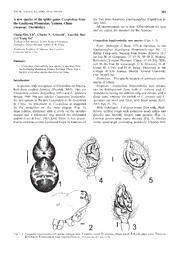
A new species of the spider genus Craspedisia from the Gaoligong Mountains, Yunnan, China (Araneae, Theridiidae) PDF
Preview A new species of the spider genus Craspedisia from the Gaoligong Mountains, Yunnan, China (Araneae, Theridiidae)
Bull.Br.arachnol.Soc.(2003)12(8),383–384 383 A new species of the spider genus Craspedisia from the 2nd Sino-American Gaoligongshan Expedition in the Gaoligong Mountains, Yunnan, China July 2002. (Araneae, Theridiidae) All measurements are in mm. Abbreviations for eyes and eye region are standard for the Araneae. Chang-Min Yin1, Charles E. Griswold2, You-Hui Bao1 and Xiang Xu1 Craspedisia longioembolia, new species (Figs. 1–5) 1CollegeofLifeScience,HunanNormalUniversity, Changsha,HunanProvince410081,P.R.China Type: Holotype _ from 2775m elevation in the 2CaliforniaAcademyofSciences,SanFrancisco, Gaoligongshan (Gaoligong Mountains) near No. 12 California94118,USA Bridge Camp area, Nujiang State Nature Reserve, 16.3 air km W of Gongshan, 27(43#N, 98(30#E, Nujiang Summary Prefecture, Yunnan Province, China, 15–19 July 2000, coll. H.-M. Yan, D. Kavanaugh, C. E. Griswold, H.-B. Craspedisialongioembolia,newspecies,isdescribedfrom Liang, D. Ubick and D.-Z. Dong. Deposited in the theGaoligongMountains,YunnanProvince,China.Thisis College of Life Science, Hunan Normal University thefirstCraspedisiaspeciesdiscoveredinChina. (No. 00-QD-30). Etymology: Thespecificnameisanarbitrarycombi- Introduction nation of letters. Atpresent,onlytwospeciesofCraspedisiaareknown, Diagnosis: Craspedisia longioembolia, new species, both from tropical America (Platnick, 2002). They are can be distinguished from both C. cornuta and C. Craspedisia cornuta (Keyserling, 1891) and C. spatulata spatulatabyhavingtheemboluslongandslender,witha Bryant, 1948. The new species, Craspedisia longioembo- sharp apex, whereas the emboli of C. cornuta and C. lia, new species, is the first Craspedisia to be discovered spatulata are short and thick, with blunt apices (Levi, in China. Its placement in Craspedisia is suggested 1963: figs. 31, 33). by the projection on the male clypeus (Fig. 2), Male (holotype): Carapace longer than wide, black- large colulus, chelicerae with a tooth on the anterior brown, surface rough with numerous small ridges and margin and a sclerotised ring around the abdominal spiculae and laterally fringed with spiculae (Fig. 1). pedicel (Levi & Levi, 1962; Levi, 1963). It was discov- Cervical groove deep, caput elevated (Fig. 2). Median eredinmontaneconifer-hardwoodforestbymembersof ocular quadrangle protruding anteriorly. Clypeus with Figs.1–5: Craspedisialongioembolia,newspecies,holotypemale.1Habitus,dorsal;2Carapace,obliquelateral;3–5Leftpalpalorgan.3Ventral; 4Prolateral;5Retrolateral.Scalelines=0.65mm(1),0.15mm(2),0.1mm(3–5). 384 AnewCraspedisiafromChina projection, appearing nose-like in lateral view (Fig. 2). Female: Unknown. Both eye rows recurved, AER more strongly (Fig. 1). Distribution: Yunnan, China. ALE and PLE contiguous. Fovea longitudinal, de- Material examined: Only the type. pressed deeply, radial grooves darker. Sternum, cheli- cerae, endites and labium red-brown, with black-brown Acknowledgements margins. Sternum with tubercles and covered with long Support for this research came from the China Natu- ciliated black hairs. Chelicera with one promarginal ral History Project, the Foundation of Natural Science tooth. Palpi and legs red-brown except femora brown, of the Education Department of Hunan Province distal end of each patella with a strong seta. Abdomen (China), the California Academy of Sciences and the ovoid,withbrokensclerotisedringsurroundingpedicel. US National Science Foundation grant DEB BSI Abdomen dorsum brown interrupted by white mark- 074632456. We are grateful to Prof. Heng Li and Prof. ings, resembling a type of facial make-up in the Beijing Chun-lin Long for support for the 2000 Sino-American opera(Fig.1),withtwopairsofround,brown,muscular expedition to the Gaoligong Mountains and to Prof. depressions in middle. Abdominal venter pale grey, Zhi-ling Dao for ably organising the expedition. We except portion before epigastric groove and spinnerets also thank all the collectors who did the difficult field- brown. Colulus with two setae. work and provided us with specimens. This is Scientific Measurements: Total length 3.18. Carapace length Contribution no. 24 from the California Academy of 1.60, width 1.11. Abdomen length 1.58, width 1.33. Eye Sciences Center for Biodiversity Research and Infor- sizes and intervals: AME 0.16, ALE 0.11, PME mation (CBRI) and contribution no. 17 from the China 0.14, PLE 0.17; AME-AME=AME-ALE=0.11, PME- Natural History Project (CNHP). PME=PME-PLE=0.14; median ocular quadrangle length=width=0.37; clypeus height 0.36. Leg measure- References ments (femur+(patella+tibia)+metatarsus+tarsus= total): I: 1.24+1.40+0.84+0.42=3.90; II: 1.11+1.22+ BRYANT, E. B. 1948: The spiders of Hispaniola. Bull. Mus. comp. 0.71+0.38=3.42; III: 0.91+0.93+0.53+0.34=2.71; IV: Zool.Harv.100:331–459. KEYSERLING, E. 1891: Brasilianische Spinnen. Die Spinnen 1.04+1.14+0.68+0.36=3.22. Leg formula I, II, IV, III. Amerikas3:1–278.Nürnberg. Palpal organ (Figs. 3–5) with patella short, arched. LEVI, H. W. & LEVI, L. R. 1962: The genera of the spider family Paracymbialhookonrimofcymbium.Medianapophy- Theridiidae.Bull.Mus.comp.Zool.Harv.127(1):1–71. sis red-brown, conductor triangular, milk-white and LEVI, H. W. 1963: The spider genera Cerocida, Hetschkia, Wirada membranous. From retrolateral view of left palpus, andCraspedisia(Araneae:Theridiidae).Psyche,Camb.70(3): 177–179. embolusbeginningatlowerright,turningclockwiseand PLATNICK, N. I. 2002: The world spider catalog, version 2.5. terminating on lower left, long and slender, with sharp <http://research.amnh.org/entomology/spiders/catalog81-87/ apex. index.html>
